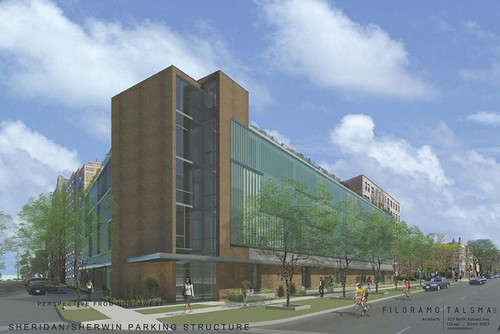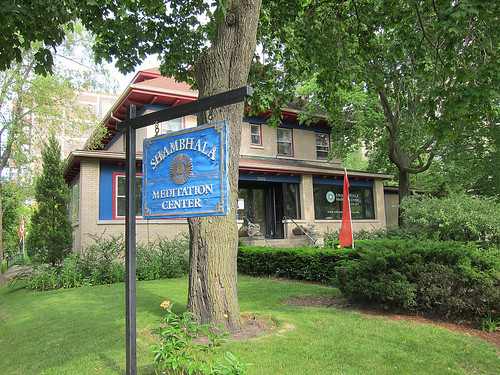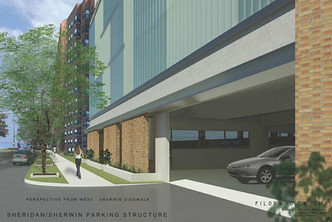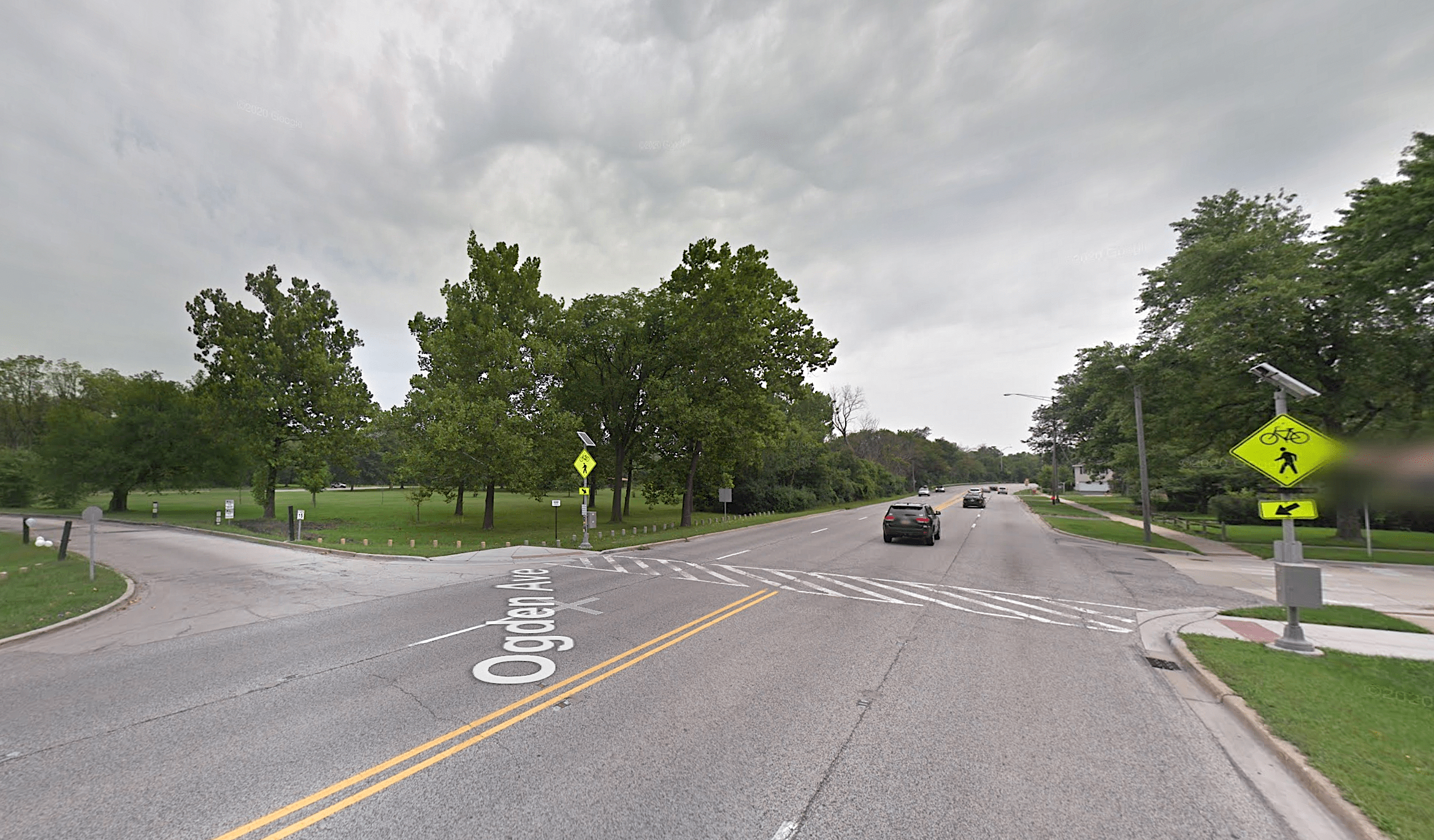49th Ward Alderman Joe Moore is one of the most progressive members of City Council and has been a strong supporter of sustainable transportation and livable streets initiatives. Most notably, he was the first American politician to introduce participatory budgeting, allowing residents to vote on how the ward’s discretionary “menu” money is spent, which has led to a number of walking, biking and transit improvements in his district.
So it’s ironic that this morning Moore announced he's throwing his weight behind a project that promises to increase car use and congestion in Rogers Park, degrading the environment for sustainable modes. The alderman is supporting a plan by Tawani Enterprises, the investment firm owned by local billionaire Colonel J.N. Pritzker, to tear down an attractive, 90-year-old house, a stone’s throw from the beach in Rogers Park, and replace it with a parking structure for 250 cars.
The garage would serve the Emil Bach House, 7415 North Sheridan, a Prairie-style home by Frank Lloyd Wright, and Farcroft by the Lake, a twelve-story upscale rental unit tower at 1337 West Fargo. Tawani is currently renovating both buildings, which are located only a few minutes walk from the CTA Red Line’s Jarvis Station. 60 parking spaces would be reserved for Farcroft residents, 84 spaces would be set aside for short- and long-term paid parking for the general public, and 106 spaces would be used during Bach House events – these spaces would be available to the public at other times.
The firm would build the four-story garage on three parcels of land at the southeast corner of Sheridan and Sherwin. The land is currently occupied by a small surface parking lot, a vacant lot where vendors sell pumpkins and Christmas trees in season, and the two-story house, formerly home to the Shambhala Meditation Center, which sits on a pretty little yard with several tall trees.
In fairness, the garage would be about as attractive as any building can be whose sole function is to warehouse cars. Although it wouldn’t include retail space, the red-brick structure would be wrapped in green recycled channel glass panels, alternating between matte and reflective finishes to create an interesting texture. After the 49th Ward zoning committee complained about the elimination of green space, Tawani altered the design to include about 2,400 square feet of grass and planters at ground level plus additional planters along the edge of the roof parking deck. After additional community feedback, current plans call for larger setbacks, some 5,000 square feet of street-level green space, and more rooftop planters.
Moore is giving his approval for a zoning change and two zoning variations to allow the parking structure to be built. Since the site falls within the Lakefront Protection District, review under the Lakefront Protection Ordinance, which was created to preserve water quality, shoreline and adjacent parkland, and approval by the Chicago Plan Commission will be needed for the project to move forward.
Many residents have opposed the project due to concerns about aesthetics, crime, construction noise, the destruction of the house and the elimination of the existing greenery. The garage’s entrance and exit would be on Sherwin, on the north end of the structure, and neighbors, including residents of a senior center next door, worry that vehicles entering and leaving will pose a hazard to pedestrians. More cars making turns to and from Sheridan will also be an issue. Others locals have noted the negative effect the garage would have on congestion.
At a well-attended community meeting in January, about three-quarters of the attendees seemed opposed to the plan. Moore says the roughly 70 emails, calls, and Facebook comments his office received in response to the meeting announcement were evenly split between support and opposition. 39 residents of the senior center signed a petition to express concerns, and an online petition against the plan drew 369 signers, 55% of whom are registered to vote in the ward.
There are several positive things that can be said about the process leading up to Moore’s decision. There was a long, extensive public input process, including several smaller community meetings. Pritzker is a longtime Rogers Park resident who has made several major investments in neighborhood revitalization, including rehabbing buildings to create a music theater, a pub, and a B & B, and Tawani has made several concessions to make the garage more acceptable to locals.
The increase in green space, plans for security guards to patrol the structure at night, and the addition of a barricade to prevent cars from exiting the facility until all pedestrians have cleared the driveway are all good things. But in many ways, they’re just window dressing. The basic problems with the garage are that it will bring hundreds of cars into the neighborhood, and it will gobble up valuable land that could be put to a more productive use.
I believe Moore's reasons for approving the proposal are altruistic. He wants to encourage Pritzker to keep doing good things in the neighborhood, and he really does seem to believe the garage will be an asset to the community. The problem is, after all the arguments from residents about why the facility will negatively impact transportation in the ward, the alderman still hasn’t wrapped his head around the concept.
Moore deserves credit for posting an in-depth, multi-page statement on the details of the proposal and his reasons for supporting it. But a long passage about why he feels the garage does not undermine his goals of reducing car dependency in Rogers Park reveals he’s still confused about this issue.
After rightfully noting the many steps he’s taken to encourage sustainable transportation, Moore writes, “Though I can dream and strive for a better tomorrow, I must also recognize the realities of the world as it is today. For thousands of people in our neighborhood today, an automobile is not a luxury, but a necessity.” He goes on to list a number of occupations and situations that seem to require the use of a car, adding that our public transportation system is not yet extensive enough to meet these needs, and not everyone is willing and able to ride a bicycle. He asks car-free constituents to emphasize with the plight of the Rogers Park driver:
Rogers Park is home to all kinds of people with different needs and varied lifestyles and values. If we are to be a truly tolerant community, we must accept the fact that some of our neighbors require the use of an automobile. Many car owners find themselves stuck in their home at night, reluctant to give up their on-street parking space. Others who drive home late at night, endlessly circle the neighborhood looking for parking, burning up fossil fuel and emitting carbon in the process. Providing those people with an easy and accessible location to store their car after a long day at work or after a late night dinner and show will add immeasurably to the quality of their life.
What Moore doesn’t get is that by making it easier to own a car in his ward, he’s making it harder to survive without one. The current scarcity of parking in Rogers Park is actually an asset, not a liability, because it encourages people to take advantage of the fact they live in a walkable, bikeable, transit-friendly neighborhood. But Pritzker’s garage will turn the dial in the opposite direction by dumping more cars into the streets, making it harder to walk, bike and ride buses. It’s a self-fulfilling prophecy: the more projects like this that get built, the more car-dependent the neighborhood will become.
“We can walk and chew gum at the same time,” Moore concludes. “We can work to achieve a more sustainable world while at the same time dealing with the realities of today.” Actually, building a structure that encourages driving will undermine the alderman’s laudable efforts to promote sustainable transportation. As former Bogotá Mayor Enrique Peñalosa has said: ”You can have a city that is very friendly to cars, or you can have a city that is very friendly to people. You cannot have both.”








